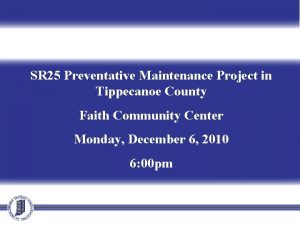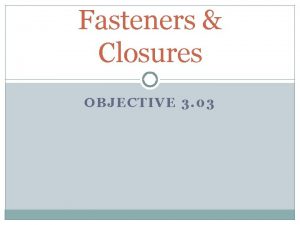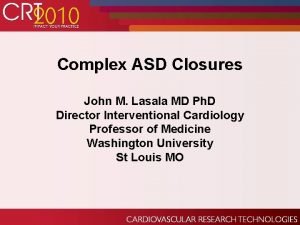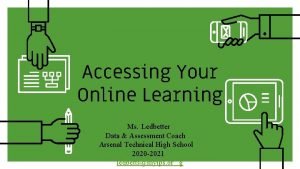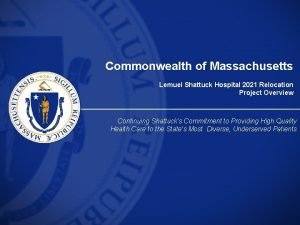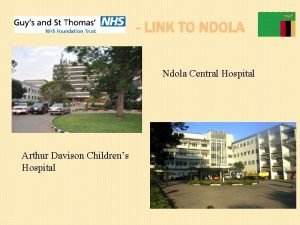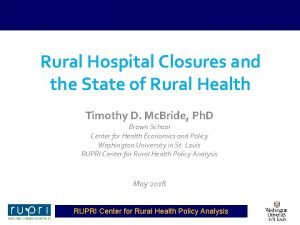Recent History of Hospital Closures the advent of










































![[biopsychosocial model] “In the Committee stages of the Welfare Reform Bill, the Government committed [biopsychosocial model] “In the Committee stages of the Welfare Reform Bill, the Government committed](https://slidetodoc.com/presentation_image_h2/2b0420f86eea8e2f99eb5a7226b5bed7/image-43.jpg)



















- Slides: 62

Recent History of Hospital Closures the advent of Direct Payments and Self Directed Support


“deviant roles” 1. Sick Person 2. Menace 3. Object of Pity 4. Burden of Charity 5. Holy Innocent

“Sick Person” • "The biological, economic and sociological bearings of feeble-mindedness have overshadowed the fact that it is fundamentally and essentially a medical question. “ Fernald (1915)

residential care for “sick people” • • • Medical hierarchy Labelled as a hospital Residents are “patients” Care is referred to as “nursing care” Living units are “units” or “wards”







“developmental model” • “designed to – facilitate and encourage the resident's interaction with the environment – maximize interaction between staff and residents – foster individuality, dignity, privacy, and personal responsibility – furnish residents with living conditions which not only permit but encourage functioning similar to that of non-handicapped community age peers”

developmental model architecture • Homelike internal and external design • Colorful, light, bright, perceptually warm but diversified living units • Small, self-contained living units • Bedrooms for 1 -4 residents • Family dining facilities • Homelike appliances such as toilets, faucets, showers, baths, stoves • Windows of normal size, type, and placement • Live-in care personnel • Plenty of space for individual possessions. • Doors between rooms and areas • Curtains or doors for baths and showers, and toilets designed for private use • Homelike access to "controls" such as switches and thermostats • Access to "risks, " e. g. , stairs, electrical outlets, hot water, etc

Scottish Learning Disability Hospitals 1995 2 1 3 1 Craig Phadrig, Inverness 2 Ladysbridge, Banff 3 Woodlands, Aberdeen 4 Strathmartine, Dundee 5 Lynebank, Dunfermline 6 RSNH, Larbert 7 Gogarburn, Edinburgh 8 St Josephs, Rosewell 9 Birkwood, Lesmahagow 10 Kirklands, Bothwell 11 Lennox Catle, Lennoxtown 12 Merchiston, Johnstone 13 Arrol Park, Ayr 12 6 11 4 5 7 13 10 9 8

we know what makes for quality in adult learning disabilities services – Respect: for • the individual • the equal adult status of the individual • the human rights of the individual – Understanding: that it’s not about “special needs” but that we all share the same human needs for • friends, love, home, community, privacy, security, money, sense of purpose – Competence: to deliver the right type and amount of additional individualised support to ensure that these needs are met

but this knowledge often fails to translate directly into practice • especially in a major undertaking like hospital closure, it can become severely diluted through various filters – national policy – local strategy – administrative complexity – the strains and stresses of the health and welfare bureaucracies attempting to work in partnership – finite resources of time and money "Deinstitutionalisation and Community Services in Greater Glasgow“ Tizard Learning Disability Review, Vol. 4 Iss: 1, pp. 13 - 23

Scotland 1995 • health and social work administered in Scotland • but policy and legislation set on a UK basis • 3, 000 -4, 000 people living in 13 learning disability “hospitals”: National Health Service • 16 National Health Service Boards • 11 Social Work Departments • no policy of hospital closure • instead a piecemeal, ad hoc, policy to reduce size of “hospital” population and develop more “community care”: – joint planning – resource transfer

National Health Service Scottish Health Boards 1995 HIGHLAND 1 Craig Phadrig, Inverness GRAMPIAN 2 Ladysbridge, Banff 3 Woodlands, Aberdeen TAYSIDE 4 Strathmartine, Dundee FIFE 5 Lynebank, Dunfermline FORTH VALLEY 6 RSNH, Larbert LOTHIAN 7 Gogarburn, Edinburgh 8 St Josephs, Rosewell LANARKSHIRE 9 Birkwood, Lesmahagow 10 Kirklands, Bothwell GREATER GLASGOW 11 Lennox Catle, Lennoxtown ARGYLL & CLYDE 12 Merchiston, Johnstone AYRSHIRE & ARRAN 13 Arrol Park, Ayr

Scottish Local Government Social Work Departments 1995 HIGHLAND 1 Craig Phadrig, Inverness GRAMPIAN 2 Ladysbridge, Banff 3 Woodlands, Aberdeen TAYSIDE 4 Strathmartine, Dundee FIFE 5 Lynebank, Dunfermline CENTRAL 6 RSNH, Larbert LOTHIAN 7 Gogarburn, Edinburgh 8 St Josephs, Rosewell STRATHCLYDE 9 Birkwood, Lesmahagow 10 Kirklands, Bothwell 11 Lennox Catle, Lennoxtown 12 Merchiston, Johnstone 13 Arrol Park, Ayr

1995: Lennox Castle “Hospital” • home for around 250 people • administered by Greater Glasgow Health Board • situated within the Strathclyde social work area…… • ……which also contained the Argyll & Clyde, Ayrshire & Arran, and Lanarkshire Health Boards

1995: Lennox Castle “Hospital” • some serious joint planning intent shown with the creation of the Greater Glasgow Joint Learning Disability Project – Greater Glasgow Health • purchaser “Board” separate from provider “Trust” – Strathclyde social work department

1995: Lennox Castle “Hospital” • Strathclyde is home area for most people……. • …. but some from every other part of Scotland • ……and there are “Strathclyde people” in every other “hospital” in Scotland (plus some in England) • the Royal Scottish National Hospital in Larbert has been developed over the years as a “national facility”

Scotland 1996 • • health and social work administered in Scotland but policy and legislation set on a UK basis 13 learning disability “hospitals”: National Health Service 16 National Health Service Boards 32 Social Work Departments no policy of hospital closure instead a piecemeal, ad hoc, policy to reduce size of “hospital” population and develop more “community care”: – joint planning – resource transfer

Scottish Local Government Social Work Departments 1996

1996: Lennox Castle “Hospital” • home for around 250 people • administered by Greater Glasgow Health Board • situated within the East Dumbarton social work area…… • ……GGHB area also contains Glasgow City, West Dumbarton, East Renfrew, [part of] South Lanarkshire and [part of] North Lanarkshire

1996: Lennox Castle “Hospital” • Glasgow City is home area for most people……. • …. but some from every other part of Scotland • ……and there are “GGHB people” in every other “hospital” in Scotland (plus some in England) • many in the Royal Scottish National Hospital in Larbert

1996: Lennox Castle “Hospital” • Greater Glasgow Joint Learning Disability Project – commissioning social care arrangements for lots of group homes • pressures of time • pressures of money – emphasising security and income maximisation through secure tenure of properties – realisation dawning that no-one is actually commissioning the housing needed!!!

1997: Lennox Castle “Hospital” • first major crisis of the “Project” • trades unions and local politicians combine in opposition • tabloid newspaper headline reads: “Sick For Sale”………. . • …. . but later that year the Secretary of State for Scotland gives permission for hospital closure

Scotland 1998 • health and social work administered in Scotland • but now policy and legislation devolved to re-established Scottish Parliament • but still – – – 13 learning disability “hospitals”: National Health Service 16 National Health Service Boards 32 Social Work Departments no policy of hospital closure instead a piecemeal, ad hoc, policy to reduce size of “hospital” population and develop more “community care”: • joint planning • resource transfer

1998: Lennox Castle “Hospital” • closure of top-site completed

Scotland 2000 • health and social work administered in Scotland • but now policy and legislation devolved to reestablished Scottish Parliament • still – 13 learning disability “hospitals”: National Health Service – 16 National Health Service Boards – 32 Social Work Department • but now hospital closure policy established in national policy document “The Same As You? ”

2001: Lennox Castle “Hospital” • hospital closure completed



“hospital” closure timeline • Craig Phadrig 1999 • Ladysbridge 2003 • Gogarburn 1999 • Strathmartine 2003 • St Joseph’s 1999 • Woodlands 2003 • Lennox Castle 2001 • Kirklands 2007 • Birkwood 2002 • Merchiston 2008 • RSNH 2002 • Lynebank • Arrol Park

enduring residential institutions • • • NHS assessment and treatment units campus-style developments “core and cluster” specialist behavioural units Nursing Homes back to the future institutions



“all the decisions that count” the advent of “Direct Payments” “Self Directed Support” “Personalisation”

“Direct Payments”, “Self-Directed Support” “personalisation” • where do we find their roots? • how are they defined and described? • what is their relationship with the system of social work? • what are the implications for the rights of individual people?

Independent Living Movement • arising out of civil rights movements of ‘ 60’s • associated with de-institutionalisation • adopting key principles and values – independent living – participation – control – choice and empowerment • asserting “Social Model of Disability” in face of prevalent “medical model”

social model of disability asserts that disability is created by three general types of social barrier, found in: • people’s attitudes — stereotyping, discrimination and prejudice • organisation’s practices — inflexible policies, practices and procedures • the built environment — including inaccessible buildings and services
![biopsychosocial model In the Committee stages of the Welfare Reform Bill the Government committed [biopsychosocial model] “In the Committee stages of the Welfare Reform Bill, the Government committed](https://slidetodoc.com/presentation_image_h2/2b0420f86eea8e2f99eb5a7226b5bed7/image-43.jpg)
[biopsychosocial model] “In the Committee stages of the Welfare Reform Bill, the Government committed itself to the use of the social model of disability…. . But when the Bill was being discussed in the House of Lords, Lord Freud announced that the Government had decided that the Bill should be based on the biopsychosocial model of disability instead. This model claims that biological, psychological and social factors all play a part in human functioning, in the context of disease or illness……. . The biopsychosocial model is about health and illness, not about impairment and disability. It has nothing to say to the situation of someone who was, for instance, born with cerebral palsy. For the majority of us with long-term illnesses, "illness behaviour" is mainly irrelevant: we're not going to get better, no matter how hard we try……. . Obviously some of us are going to recover, go back to work, lead normal lives again. That's wonderful. But many of us are not. I have progressive MS. I'm not going to be getting better - I'm going to get worse, and there is absolutely no way I'm fit to work at present…. . But because the government has chosen the biopsychosocial model, there's a very real risk that after a year I'll be forced onto Jobseeker's Allowance: and face having it removed if I don't turn up for interviews because I'm unable to get out of bed. ” http: //funkymangosmusings. blogspot. co. uk/2012/01/modelling-disabilityspartacusreport. html

Direct Payments • cash payments made directly to the individual to purchase the services they are assessed as requiring. • a key goal of the disability movement for many years • seen as playing a role in the struggle for both redistribution and recognition • not legislated for until 1996 – Community Care (Direct Payments) Act – same year that hospital closure programmes began in earnest

Direct Payments • allowing disabled people the freedom to determine the types of assistance they require, the quality of services available would be improved. • direct payments are regarded as having the potential to improve the social status of disabled people by transforming their identity from that of passive service recipient to active employer

Self-Directed Support • a development of the 2000’s with intention of – making direct payments more flexible – Increasing the take-up of Direct Payments – extending the range of people with access to Direct Payments • introduction of new campaigns like In Control and In Control Scotland • other disability and “community care” groups becoming involved

personalisation “by putting users at the heart of services, by enabling them to become participants in the design and delivery, services will be more effective by mobilising millions of people as co-producers of the public goods they value. ” “PERSONALISATION THROUGH PARTICIPATION” CHARLES LEADBETTER, 2004

UK Government and personalisation is “the process by which services are tailored to the needs and preferences of citizens. The overall vision is that the state should empower citizens to shape their own lives and the services they receive. ” PRIME MINISTER’S STRATEGY UNIT (2007) “HM GOVERNMENT REVIEW: BUILDING ON PROGRESS: PUBLIC SERVICES”

Scottish Government and Self-Directed Support “the Bill published today will give individuals informed choice and promote positive collaboration between recipients of social care and those who provide services on their behalf. There has been extensive consultation and engagement with stakeholders on the way forward and I am confident the Bill will help us build on the very positive progress made in implementing our 10 year strategy to providing real choice and control for those receiving social care. " MICHAEL MATHESON, PRESS STATEMENT, MARCH 2012

Scottish Government and Self-Directed Support the Social Care (Self Directed Support) (Scotland) Act, 2013

the direction of travel • • • foundational thinking and values broad public policy thrust specific Scottish social work policy current Scottish legislation report of the Christie Commission …………………. . so what’s the snag? ?

“personalisation already the goal” “a version of personalisation is already the goal of the Scottish social care system. But it is a goal the system fails to reach consistently. The 1968 Social Work Scotland Act, which inaugurated modern generic social work, set the goals of social work that most social workers still ascribe to today…. ” “PERSONALISATION AND PARTICIPATION: THE FUTURE OF SOCIAL CARE IN SCOTLAND, FINAL REPORT” CHARLES LEADBETTER & HANNAH LOWNSBROUGH, NOVEMBER 2005

resource and risk management “yet the testimony of both professionals, care staff and clients is that the social work system often fails to deliver on these goals. In practice social workers seem to be risk managers and resource allocators, gatekeepers and controllers, often working with clients in crisis when the task is to save them from harming themselves or others” “PERSONALISATION AND PARTICIPATION: THE FUTURE OF SOCIAL CARE IN SCOTLAND, FINAL REPORT” CHARLES LEADBETTER & HANNAH LOWNSBROUGH, NOVEMBER 2005

resource and risk management “Social Work is formally committed to deliver a set of goals – which embrace the ideals of person centred support – and yet the system works to a completely different logic to control risk and resources” “PERSONALISATION AND PARTICIPATION: THE FUTURE OF SOCIAL CARE IN SCOTLAND, FINAL REPORT” CHARLES LEADBETTER & HANNAH LOWNSBROUGH, NOVEMBER 2005

“all the decisions that count” “…our workshops and interviews with service users ……. uncovered a feeling among many that the service they receive is driven not by what people need but by what the system can deliver: it feels as if the professionals and system make all the decisions that count. Many of the clients feel as if the professionals are in charge and they have no choice. ” [EMPHASIS IN ORIGINAL] “PERSONALISATION AND PARTICIPATION: THE FUTURE OF SOCIAL CARE IN SCOTLAND, FINAL REPORT” CHARLES LEADBETTER & HANNAH LOWNSBROUGH, NOVEMBER 2005

the privileges of personalisation • the choice, control and autonomy proposed and long promised through “personalisation” seem to represent a set of privileges rather than a set of rights • a set of privileges variously afforded or denied, allocated or withdrawn in the absence of consistent criteria • a set of privileges determined by professionals not acting on behalf of the “person”, but acting on behalf of the state through the apparatus of local government

personalisation by right • it’s not acceptable that the basic freedoms personalisation encompasses – participation, control, choice, self-determination, equally valued citizenship, the power to make informed decisions about your own life – should be in the gift of others or of the state • these are rights - not privileges • and in the absence of these rights being respected by the system it is necessary for them to be asserted and claimed

Living Independently and Being Included Article 19 of the Convention on the Rights of People with Disabilities • the right to live independently and live in the community • the right to the same choice and control as non-disabled people • the responsibility of Government to do everything it can to ensure that disabled people enjoy these rights

Private Home and Family Life Article 8 of the European Convention on Human Rights • the right to respect for – private and family life – home – correspondence • the right to informed consent to any limitations placed on human rights • the right to personal autonomy and personal development • the right to conduct life in the manner of one’s choosing

no exceptions • the ECHR prohibits discrimination on any ground • provision of services must be assessed for indirectly discriminatory impacts • taken together with a human rights based approach to issues of capacity (e. g. , under S 12 of the Disability Convention) personalisation becomes – an approach for all regardless of status – not contingent upon meeting certain criteria

Self-directed support, and “austerity” clear moral and political issues arise for people, professionals and society as a whole when levels of global funding become so deficient as to render safe levels of social care difficult or impossible to achieve

principles at stake • the balance of power and control rests with the individual and group being served and not with the worker or the employing agency • no matter the value and importance of “coproduction” and “partnership”, the rights and empowerment of the individual or group take priority over process or the professional relationship • the “entitlements” of individuals or groups are not trumped by the need to “protect public money” or by “the interests of the Council”
 Advent es ist advent
Advent es ist advent Rjvet
Rjvet Tippecanoe county road closures
Tippecanoe county road closures Self sealability test
Self sealability test Types of button closures
Types of button closures Closures of relations
Closures of relations End closures without tie-bar
End closures without tie-bar Dr john lasala
Dr john lasala Organization of hospital pharmacy
Organization of hospital pharmacy Recent trends in ic engine
Recent trends in ic engine Recent developments in ict
Recent developments in ict Recent developments in object detection
Recent developments in object detection Many recent college graduates have faced
Many recent college graduates have faced Foreign trade
Foreign trade Scanning reading benefits
Scanning reading benefits Modern trends in project management
Modern trends in project management Recent demographic changes in the uk
Recent demographic changes in the uk Powerschool myips
Powerschool myips Stippling
Stippling After kato's serious motorcycle accident
After kato's serious motorcycle accident A friend emails you the results of a recent high school
A friend emails you the results of a recent high school Recent advances in dental ceramics
Recent advances in dental ceramics Passive voice news report
Passive voice news report Https drive google com
Https drive google com Can backdated udin be generated
Can backdated udin be generated Mis trends
Mis trends Mpgu
Mpgu Lemuel shattuck hospital history
Lemuel shattuck hospital history Arthur davison
Arthur davison Hát kết hợp bộ gõ cơ thể
Hát kết hợp bộ gõ cơ thể Bổ thể
Bổ thể Tỉ lệ cơ thể trẻ em
Tỉ lệ cơ thể trẻ em Voi kéo gỗ như thế nào
Voi kéo gỗ như thế nào Glasgow thang điểm
Glasgow thang điểm Chúa yêu trần thế alleluia
Chúa yêu trần thế alleluia Các môn thể thao bắt đầu bằng tiếng bóng
Các môn thể thao bắt đầu bằng tiếng bóng Thế nào là hệ số cao nhất
Thế nào là hệ số cao nhất Các châu lục và đại dương trên thế giới
Các châu lục và đại dương trên thế giới Công của trọng lực
Công của trọng lực Trời xanh đây là của chúng ta thể thơ
Trời xanh đây là của chúng ta thể thơ Cách giải mật thư tọa độ
Cách giải mật thư tọa độ Phép trừ bù
Phép trừ bù độ dài liên kết
độ dài liên kết Các châu lục và đại dương trên thế giới
Các châu lục và đại dương trên thế giới Thơ thất ngôn tứ tuyệt đường luật
Thơ thất ngôn tứ tuyệt đường luật Quá trình desamine hóa có thể tạo ra
Quá trình desamine hóa có thể tạo ra Một số thể thơ truyền thống
Một số thể thơ truyền thống Cái miệng nó xinh thế chỉ nói điều hay thôi
Cái miệng nó xinh thế chỉ nói điều hay thôi Vẽ hình chiếu vuông góc của vật thể sau
Vẽ hình chiếu vuông góc của vật thể sau Thế nào là sự mỏi cơ
Thế nào là sự mỏi cơ đặc điểm cơ thể của người tối cổ
đặc điểm cơ thể của người tối cổ V cc
V cc Vẽ hình chiếu đứng bằng cạnh của vật thể
Vẽ hình chiếu đứng bằng cạnh của vật thể Vẽ hình chiếu vuông góc của vật thể sau
Vẽ hình chiếu vuông góc của vật thể sau Thẻ vin
Thẻ vin đại từ thay thế
đại từ thay thế điện thế nghỉ
điện thế nghỉ Tư thế ngồi viết
Tư thế ngồi viết Diễn thế sinh thái là
Diễn thế sinh thái là Các loại đột biến cấu trúc nhiễm sắc thể
Các loại đột biến cấu trúc nhiễm sắc thể So nguyen to
So nguyen to Tư thế ngồi viết
Tư thế ngồi viết


